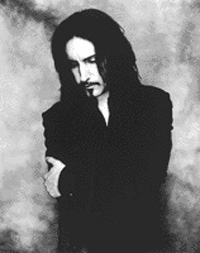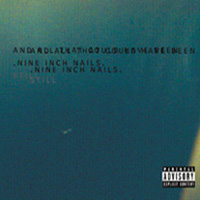 Nine Inch Nails
Nine Inch Nails
Closure (Nothing/Interscope/Trimark Home Video)
by Nik Rainey
If there’s anyone out there still harboring the notion that life on the road for a rock band is imbued with some mythical/mystical mojo, a few more tour documentaries like the one that makes up the first of the two-cassette Nine Inch Nails video collection, closure, should help disabuse them of it. Not that NIN comes off appreciably worse than any of the thousand or so personality-deficient combos that have followed a winding trail of upraised lighters for the benefit of the cameras; indeed, that may be the problem. Take away the frenetic cross-cutting, the speedball editing, and enough strobe-lit concert sequences to send every Japanese youngster into a prolonged seizure, and you’ve got something exactly as banal and ultimately pointless as any of the roadtrips you took with your folks in the station wagon when you were a sprout. (Granted, your parents probably didn’t wear nearly as much S&M-inspired leather gear – then again, maybe they did; who can say in this day and age?) For a band (or, to be more accurate, a man) that is one of the more interesting success stories of the decade, with all the fascinating contradictions and compromises involved in popularizing a marginal musical genre, exorcising highly personal demons in front of capacity crowds, and trying to maintain the creative purity that gained him/them success in the first place, it’s a pity that this reeks of the kind of uncritical vanity production designed only to tickle the fancy of fetishists. There’s a deeper story here – Trent Reznor impresses me as a smart, sensitive guy with an unfortunate willingness to surround himself with the most tired forms of decadence (enough with the Jim Rose Sideshow already), and one wonders whether he feels trapped by the attenuations of the world he’s constructed around him. But you’ll never know from this, some impressive performance segments notwithstanding – sure, one of the band members flings out a Spinal Tap quote at one point, demonstrating the shift from self-indulgent obliviousness to self-indulgent self-awareness on the part of rockumentary subjects. The difference is, that movie had a dramatic structure and a point. The only points made here were from the beer bottles flung against the dressing room walls. Ooh, scary stuff.
 All of which is as strong a defense of the art of videos as I can think of. Nice, succinct, and crammed with as much drama, imagery, and character as the former lacks, the Nails’ promo pieces are models of the form, and the second half of closure contains the lot, uncut, chronologically arranged, and tied together with bizarre filmclips (like a 1903 Thomas Edison film entitled “Electrocuting an Elephant”) by avant-vid master Peter “Sleazy” Christopherson (Throbbing Gristle, Coil). Here, too, the relentless barrage of bleak symbolism and stylized squalor can get a tad wearying in a single sitting, but even so, you’re unlikely to find a better demonstration of the form’s potential and capacity in one place. The early, Pretty Hate Machine-era clips (even the R-rated one for “Sin”) are good but embryonic in comparison to the startling ones that follow, which manage a bracing viscerality in even the straightforward performance clips (Christopherson’s takes on “Wish” and the live-on-tape “March of the Pigs”), but the real hook here is the inclusion of a couple of the most notorious videos ever made. The uncut “Closer” isn’t really the shocker that legend would have you believe, beautifully made as it is (the biggest surprise here is finding the picture of Jack Nicholson taped up beside the crucified monkey), and it’s strictly wussville up against the De Sade-meets-Eraserhead piece of industrial revulsion that is “Happiness in Slavery,” one of the most graphic, horrific, and utterly mesmerizing videos ever produced. And with “The Perfect Drug,” Reznor appears to be edging into a more elegant and romantic version of the decadence he’s popularized, giving one hope that perhaps the title of this compendium is true and that he’s finding new avenues of expression after the brilliant dead-end of The Downward Spiral and the constant wheel-spinning of his remix and soundtrack projects since then. His next album is expected this year – we await his possible emergence from the overpopulated darkness.
All of which is as strong a defense of the art of videos as I can think of. Nice, succinct, and crammed with as much drama, imagery, and character as the former lacks, the Nails’ promo pieces are models of the form, and the second half of closure contains the lot, uncut, chronologically arranged, and tied together with bizarre filmclips (like a 1903 Thomas Edison film entitled “Electrocuting an Elephant”) by avant-vid master Peter “Sleazy” Christopherson (Throbbing Gristle, Coil). Here, too, the relentless barrage of bleak symbolism and stylized squalor can get a tad wearying in a single sitting, but even so, you’re unlikely to find a better demonstration of the form’s potential and capacity in one place. The early, Pretty Hate Machine-era clips (even the R-rated one for “Sin”) are good but embryonic in comparison to the startling ones that follow, which manage a bracing viscerality in even the straightforward performance clips (Christopherson’s takes on “Wish” and the live-on-tape “March of the Pigs”), but the real hook here is the inclusion of a couple of the most notorious videos ever made. The uncut “Closer” isn’t really the shocker that legend would have you believe, beautifully made as it is (the biggest surprise here is finding the picture of Jack Nicholson taped up beside the crucified monkey), and it’s strictly wussville up against the De Sade-meets-Eraserhead piece of industrial revulsion that is “Happiness in Slavery,” one of the most graphic, horrific, and utterly mesmerizing videos ever produced. And with “The Perfect Drug,” Reznor appears to be edging into a more elegant and romantic version of the decadence he’s popularized, giving one hope that perhaps the title of this compendium is true and that he’s finding new avenues of expression after the brilliant dead-end of The Downward Spiral and the constant wheel-spinning of his remix and soundtrack projects since then. His next album is expected this year – we await his possible emergence from the overpopulated darkness.



